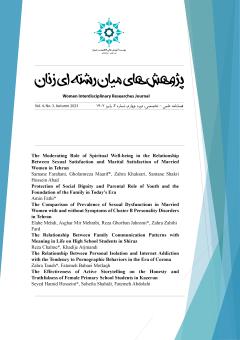The Effectiveness of Active Storytelling on the Honesty and Truthfulness of Female Primary School Students in Kazerun
Subject Areas :
seyed hamid Hosseini
1
,
soheila shahidi
2
,
fatemeh abdolahi
3
![]()
1 - Ph.D in general psychology, Islamic Azad University, Maroodasht branch, Marvdasht, Iran.
2 - M.A student in General Psychology, Fatemiyeh Shiraz Institute of Higher Education, Shiraz, Iran.
3 - M. A in General Psychology, Fatemiyeh Shiraz Institute of Higher Education, Shiraz, Iran.
Keywords: Active storytelling method, Honesty and truthfulness, Female primary school students.,
Abstract :
The aim of this study was to investigate the effectiveness of active storytelling method on honesty and truthfulness of female primary school students in Kazerun. The present research method was a quasi-experimental research method. The statistical population of the present study included primary school students in Kazerun that 30 people were randomly selected as a sample and were divided into two groups of control and experimental. The experimental group consisted of 15 people and the control group consisted of 15 people. The instruments of the present study included a questionnaire of 16 questions of honesty and truthfulness of Zare et al. (2011) and a preliminary study and library resources. The results showed that there was a significant difference between the mean difference of pre-test and post-test scores in the control group and the experimental group. Also, according to the significant level of independent sig t, which is equal to 0.001 and is less than the assumed value of 5%. (0.001> P). Honesty and truthfulness are excellent moral qualities of human beings and the effectiveness of storytelling on life and future and honesty of children has been proven. Also, up-to-date technology and technologies can be used in active storytelling. Choosing useful apps and storybooks is very helpful. And families need to pay attention to this.
1- امامی، ش.، نوری، ا.، ملک پور، م.، و عابدی، ا. (1390). رابطه بین دلبستگی کودک و عوامل رفتار مادرانه. تحقیقات خانواده، 7(3)، 293-310.
2- تاتاری، م.، عایش، ز.، مولایی، ح.، و دوستانی بردی، م. (۱۳۹۵). ارزیابی و تحلیل جایگاه قصه و قصهگویی در ادبیات کودکان و نقش آن در فرایند یاددهی- یادگیری دانش آموزان دورهی ابتدایی. کنگره بینالمللی زبان و ادبیات، مشهد.
3- تاجآبادی، ر.، موحدیان، س.، و شعبانی، س. (۱۳۹۶). نقش کاربردی قصههای قرآنی در رفتار و اخلاق دینی دانش آموزان (با تأکید بر قصهگویی به شیوه قران کریم). همایش کشوری.
4- چلبی، م. (۱۳۸۵). تحلیل اجتماعی در فضای کنش. نشر نی، تهران.
5- حجازی، ب. (1390). ادبیات کودکان و نوجوانان. انتشارات روشنگران و مطالعات زنان. تهران.
6- خادمی، م.، و مهرولی، ف. (۱۳۹۴). بررسی قصهگویی قرآن بهعنوان روشی فعال در آموزش اخلاق. فصلنامه علمی تربیت اسلامی، ۱۰(۲۰)، ۵۱-۷۹.
7- داداش زاده، س.، و پیرخائفي، ع. (۱۳۹۴). بررسی اثر بخشی استفاده از روش های قصه گویی بر افزایش هوش اجتماعی دانش آموزان دختر مقطع جهارم و پنجم ابتدایی در سال ۹۱-۹۰. نشریه علمی آموزش و ارزشیابی (فصلنامه)، 8(29)، 21-29.
8- رالز، ج. (1380). عدالت بهمثابه انصاف یک بازگویی. ترجمه ثابتی، ع. انتشارات ققنوس، تهران.
9- روشن چلسی، ر. (1392). تأثیر قصهگویی مبتنی بر آموزش مهارتهای اجتماعی بر بهبود مهارتهای اجتماعی و مشکلات رفتاری دانش آموزان پسر 8 تا 10 ساله مبتلا به اختلال نافرمانی مقابلهای و بیاعتنائی. فصلنامه روانشناسی بالینی، 10(3)، 74-94.
10- شجاعی، س.، بهرامی، ه.، و شجاعی، ح. (۱۳۹۲). تأثیر قصهگویی به روششناختی رفتاری بر کاهش پرخاشگری کودکان پیشدبستانی شهر ایلام. کنگره سراسری روانشناسی کودک و نوجوان.
11- غلامی زارع زاده، ف. (۱۳۹۵). تأثیر قصههای قرآن کریم بر تربیت و رشد کودکان. همایش سراسری علمی- پژوهشی سبک زندگی، تایباد.
12- فرهادی راد، ح.، هاشمی، س. ج.، و رحمتی، ف. (1397). الگوی مشترک «بهترین تجارب تدریس»: علّتها، زمینهسازها و راهبردها. نشریه علمی آموزش و ارزشیابی (فصلنامه)، 11(42)،91-115.
13- مطهری، م. (۱۳۹۷). تعلیم و تربیت در اسلام. انتشارات صدرا، تهران.
14- نقدي، و.، و تولايي، ن. (1392). مطالعه جامعه شناختي رعايت هنجار اخلاقي صداقت در جوانان با تاکيد بر روش¬هاي تربيتي خانواده و مدرسه. مسائل اجتماعی ایران (دانشگاه خوارزمی)، 4(2)، 155-172.
15- ولی¬پور، ج.، و گرجی پشتی، م. (1395). فرا تحليل قصه گويي برميزان يادگيري دانش آموزان مقطع ابتدايي. فصلنامه پژوهشهای برنامهریزی آموزشی و درسی، 6(1)، 15-26.
16- Gasparini, S. (2021). Collaborative storytelling in distance education: a preliminary research with pre-school children. Form@ re-Open Journal per la formazione in rete, 21(1), 219-234.
17- Glassner, A. (1999). Active Storytelling. The Eurographics Association and Blackwell Publishers.
18- Heffner, M. (2003). Experimental support for the use of story telling to guide behavior: the effects of story telling on multiple and mixed fixed ratio (FR)/differential reinforcement of low rate (DRL) schedule responding. West Virginia University.
19- Kumari, A., & Yadav, R. (2017). Developing relationship skills among students: Role of story telling. Educational Quest-An International Journal of Education and Applied Social Sciences, 8(3), 447-451.
20- Mendoza, K., & Bradley, L. (2021). Using Storytelling for Counseling With Children Who Have Experienced Trauma. Journal of Mental Health Counseling, 43(1), 1-18.
21- Miller, T. W., Nigg, J. T., & Miller, R. L. (2009). Attention deficit hyperactivity disorder in African American children: what can be concluded from the past ten years?. Clinical psychology review, 29(1), 77-86.
22- Suggate, S. P., Lenhart, J., Vaahtoranta, E., & Lenhard, W. (2021). Interactive elaborative storytelling fosters vocabulary in pre-schoolers compared to repeated-reading and phonemic awareness interventions. Cognitive Development, 57, 100996.


